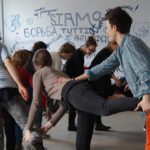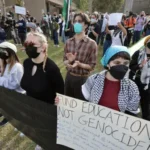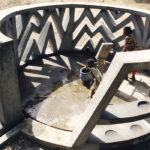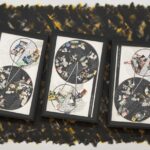How Much Remains of What Was Not?
André Mesquita
“How Much Remains of What Was Not?”[1]
I’m writing this text exactly 137 days since the brutal murder in Rio de Janeiro of sociologist, feminist and human rights activist Marielle Franco.[2] I’m writing just two months before the presidential elections in Brazil and five years after the so-called “June Days” in 2013, when the streets were taken by social movements.[3] I don’t want to make this report a balance or review of the acts and consequences of 2013, much less propose a frightening prediction of what will be the elections this year, but try to sketch brief reflections from episodes of censorship and authoritarianism, as well as actions of resistance in Brazil in the context of our recent social and political scenario.
First, to remember that in 2016 we had a coup (and I will not use this word in quotation marks) in Brazil, putting an illegitimate government in power at the service of the economic elites. This coup was accompanied by a strong neoconservative wave that took the societies and governments of Latin America. It should also be remembered that in Brazil, the authoritarianism of the State and the classist and racist violence of its institutional and police agents didn’t disappear with the end of military dictatorships. There is no doubt that this violence – which is also a remnant of colonial and slavery inheritance – has intensified and returned in an overwhelming way in recent decades with neoliberal policies and the financialization of the economy.[4] As explained in the Red Conceptualismos del Sur statement published in November 2016:
The substitution of the force of the arms by the force of the desire is a necessity of the financial capitalism for which military dictatorships are a hindrance for its free international flow. The new capitalist regime needs a minimal and flexible state, the neoliberal state, which auctions the country’s patrimony and gives free passage to the local economy’s takeover of the local economy – whose goals include, among others, the precariousness of labor as means of exorbitant accumulation, updated version of the primitive accumulation generated by slave labor. […] Direct violence is a systematic in the implementation of financial capitalism. Weapons are used by various facets of military power: weapons in the peripheries always firing and killing, targeting the black population as a prime target; weapons as an instrument of repression in the streets, in movements against the coup, through extreme police violence, now trained by the army with new strategies and technologies.[5]
What do we learn from a situation of social instability and regression? How have artists and activists reacted to systematic processes of economic, gender and racial violence in Brazil in recent years? How did the conservative wave attack cultural projects? Here are at least two crucial points in this scenario that I think are important to be highlighted:
1-The politics of the movements: If there was something profoundly impacting and pedagogical about the forms of self-organization in these recent years, this something was, for example, the occupations carried out by the secondary students from the end of 2015 in São Paulo. Against the precariousness of education and the cuts in education, young students between the ages of 15 and 18 began to occupy public schools, converting them into non-hierarchical spaces to exercise direct participation in public life. The schools were transformed into assembly places among the students, promoting open classes, musical presentations and artistic interventions. With an immense degree of dedication, the secondary students themselves were responsible for taking care of the internal maintenance of the schools, for the cleaning of the spaces and the preparation of meals. Through widespread reports on social networks, they have publicized the State’s neglect by showing photos and videos of abandoned books and food in public school rooms that were never distributed to students.


One effect of student occupations was the increasingly explicit perception that social struggles are not separated by movements, but connected. Secondaries were absolutely supportive to the demands of human rights groups against genocide in the Brazilian peripheries, as in the case of the Mothers of May Movement, an organization formed in May 2006 after security forces and death squads executed more than 600 people in the peripheries of the State of São Paulo. The Mothers of May Movement is one of the most important organizations against State terrorism in Brazil, conducting political acts, engaging in public discussions and demonstrations on the streets, giving interviews or making use of social media to post complaints, letters and reflections to request the reopening and federalization of investigations into the crimes of 2006, along with police demilitarization and the material and psychological reparation of damages for the families involved.[6] Recently, the activist Débora Maria da Silva, founder of the Mothers of May Movement, carried out a joint research with forensic anthropologists of the Federal University of São Paulo (Unifesp), published in a report in 2018 that shows the participation of public agents in death squads in 2006 and the closure of investigations by the government of the State of São Paulo. The direct engagement of an activist who lost her son in 2006 in an academic study on State violence signals a change in the relationships that are established between researchers and social movements. In addition to what the notion of “militant research” proposes, rather than the social movement being analyzed by an academic, it is the militant who goes to the university to investigate those who study and control it.[7]

2-Art responds to what? The first artistic act against the impeachment of Dilma Rousseff took place in March 2016 in a Facebook group called ArtePelaDemocracia, formed by Brazilian artists and curators who began a graphic campaign to support the President through posters distributed over the internet and used in demonstrations.[8] When Michel Temer temporarily took over the presidency in May 2016, he announced a reform of the Ministry of Culture (MinC). Against the possible drastic changes, artists occupied different cultural spaces in Brazil linked to the MinC and produced collective workshops. Some posters and shirts with the phrase “Fora Temer” [Get Out Temer] came to be taken by the public in the Brazilian stadiums during the Olympic Games, but many protesters were eventually repressed and even expelled by security agents. For the International Olympic Committee (IOC), “games should not be politicized.”[9]
Repression was taking place in the stadiums and on the streets, but acts of censorship and criminalization have reached the art world. With the political polarization that took the social networks, right-wing groups and fundamentalist religious leaders understood that the cultural institutions in Brazil are also a territory of discussion and visibility of moralistic demands. These groups have tried to censor art exhibits and museums to spell out the worst on their agenda – from campaigns against abortion to homophobic statements.
The first exhibition to be attacked was Queermuseu – Cartographies of Difference in Brazilian Art, curated by Gaudêncio Fidelis in a cultural space run by a bank in the city of Porto Alegre. In September 2017, the exhibition was abruptly closed by the museum after a defamation campaign by extreme right-wing groups that grew up after the impeachment, claiming that works of the exhibition incited “pedophilia”, “bestiality”, and “blasphemy.” A new attack occurred after the performance of artist Wagner Schwartz at the opening of the thirty-fifth Panorama of Brazilian Art at the Museu de Arte Moderna de Paulo (MAM-SP). Naked, the artist allowed the audience to manipulate his body as a geometric object, creating a reference to Lygia Clark’s Bichos series.[10] A video posted on social networks showed a mother with her daughter touching Schwartz’s arms and legs. That was enough for these authoritarian groups to call Schwartz a “pedophile,” turned into a criminal and threaten him. As if that were not enough, on her travel to Brazil for a seminar in October 2017, Judith Butler was the target of an insane anonymous campaign of ultraconservative groups and a petition with 320,000 sign-ups requesting the cancellation of her visit. All this because the right-wing in Brazil views Butler’s gender discussions as “a threat to the family and children’s values.” In 2014, the Sao Paulo Biennial also featured works that discussed themes related to sexuality, but although there were some isolated conservative protests, the biennial wasn’t closed. Times changed rapidly.[11]
What future do we have when fundamental basic rights, freedom of expression and the very lives of people are maliciously attacked, persecuted and threatened? We need to be persistent in order to advance in a terrible atmosphere of social lethargy and poverty in political discussions. There are many social struggles with regard to the defense of the rights of indigenous and black populations, and LGBTQ movements in Brazil, but we still face a daily confrontation with hate speeches and fake news that deprive a critical possibility of thinking in an unreasonable moralism. The results of this tragic conjuncture will take many years to be transformed, but it is necessary not to fear terror to fight urgently its advance.
André Mesquita is based in São Paulo and conducts research on the articulations between art, politics, and activism. He received his PhD in Social History from the University of São Paulo in the Faculty of Philosophy, Languages and Literature, and Human Sciences. He is the author of the following books: Insurgências poéticas: arte ativista e ação coletiva (Annablume/Fapesp, 2011), Esperar não é saber: arte entre o silêncio e a evidência (2015) – realized with funding from Bolsa Funarte de Estímulo à Produção em Artes Visuais 2014 –, Mapas dissidentes (TBA), and co-author of Desinventario: esquirlas de Tucumán Arde en el archivo de Graciela Carnevale (Ocho Libros, 2015). In 2014, Mesquita was the resident researcher at the Museo Nacional Centro de Arte Reina Sofía in Spain. As a member of the Red Conceptualismos del Sur (Southern Conceptualisms Network), he was one the curators of Perder la forma humana: una imagen sísmica de los años ochenta en América Latina (Museo Reina Sofía, 2012) and contributor to the accompanying exhibition publication. Also, he was the co-curator of the exhibition Politicization of Friendship (Moderna Galerija/Museum of Contemporary Art Metelkova, Ljubljana, 2014). Currently, Mesquita investigates the theme of secrecy and its relationships with contemporary societies and artistic practices. André is the Head of mediation and public programs at the Museu de Arte de São Paulo (MASP). http://andremesquita.redezero.org
Notes
[1] In portuguese: “Quanto resta do que não foi?”. Sentence found in a poster pasted on a wall in São Paulo. The first time I saw this phrase was next to a graffiti with the face of Marielle Franco.
[2] See Juliana Neuenschwander and Marcus Giraldes, “Marielle Franco: 1979–2018”, in New Left Review, number 110, March-April 2018. https://newleftreview.org/II/110/juliana-neuenschwander-marcus-giraldes-marielle-franco-1979-2018.
[3] For a reflection in English produced in 2013 on the composition of leftist movements and movements during that period, see Raúl Zibechi, “Autonomy in Brazil: below and behind the June uprising”, in ROAR, November 21, 2013. https://roarmag.org/essays/raul-zibechi-brazilian-uprisings.
[4] See Suely Rolnik. “O novo tipo de golpe de estado: um seriado em três temporadas”, in El País, May 12, 2018. https://brasil.elpais.com/brasil/2018/05/12/actualidad/1526080535_988288.html
[5] Red Conceptualismos del Sur. “Não Temer o mundo, mas enfrentá-lo para criar outros mundos!”, November 13, 2016. https://redcsur.net/es/manifiestos-e-intervenciones/nao-temer-o-mundo-mas-enfrenta-lo-para-criar-outros-mundos. The Red Conceptualismos del Sur [Southern Conceptualisms Network] is an international platform for collective production, reflection, and setting in common of a political position. This network was founded towards the end of 2007 by a group of researchers concerned with the need for a political intervention into the processes of neutralizing of the critical potential of a set of “conceptual practices” which had taken place in Latin America since the 1970s.
[6] About The Mothers of May Movement in english, see my text “Pedagogies of struggle: Art and Activism in Dialogue, Listening, and Memory Experiences”. Bill Kelley, Jr and Rebecca Zamora (eds.). Talking to Action: Art, Pedagogy, and Activism in the Americas. Illinois: University of Chicago Press, 2017, pp. 71-81; and my book Esperar não é saber: arte entre o silêncio e a evidência. São Paulo, 2015. http://andremesquita.redezero.org/wp-content/uploads/2016/04/esperarnaoesaber-andremesquita.pdf.
[7] See the report Violência de Estado no Brasil: uma análise dos Crimes de Maio de 2006 na perspectiva da antropologia forense e da justiça de transição, 2018. https://www.unifesp.br/reitoria/caaf/images/Relatorio_final_2.pdf.
[8] See https://www.facebook.com/artepelademocraciacartazes.
[9] Débora Melo. “O ‘Fora Temer’ e a censura nas Olimpíadas”, in Carta Capital, August 9, 2016. https://www.cartacapital.com.br/politica/o-fora-temer-e-a-censura-nas-olimpiadas.
[10] A vídeo about Lygia Clark’s Bichos: https://www.youtube.com/watch?v=7Cq2OVD7dvA
[11] About these recent events, see Jota Mombaça. “Beneath Butler: Cruising Brazilian Dystopia”, in e-flux, December 2017. https://conversations.e-flux.com/t/beneath-butler-cruising-brazilian-dystopia/7463.







